
¡Hola, esto es Waralwa!
Hi, I hope you are feeling great!
En esta clase avanzamos con las "valoraciones de colores". Entre ellas tenemos las **Monocromáticas**, elegimos un solo color y lo llevamos hacia lo blanco y hacia lo oscuro. **Complementarios**, aquí tomamos ambos complementarios y vamos acercando la mezcla a cada color puro y creamos más colores. Por último, los **Análogos**, para esto tomamos una parte de los colores del Círculo cromático y observamos la gamma de colores obtenida.
Una vez sabemos combinar estos colores, la profesora nos mostró el uso de las técnicas: Húmedo sobre húmedo y húmedo sobre seco. Las cuales utilizamos para pintar la rama de Olivo. Los fruto lo pintamos con húmedo sobre húmedo y las ramas con la otra técnica. El agua sigue siendo importante para plasmar las luces y sombras. Además, le dí 2 pasadas de pintura para que mantega su color vivo.
In this class we move on to ‘color assessments’. Among them we have the Monochromatic, we choose a single color and take it in the direction of white and dark. Complementary, here we take both complementary colors and move the mixture to each pure color and create more colors. Finally, the Analogues, for this we take a part of the colors of the chromatic circle and we observe the gamma of colors obtained.
Once we knew how to combine these colors, the teacher showed us how to use the techniques: wet on wet and wet on dry. We used them to paint the olive branch. We painted the fruit with wet on wet and the branches with the other technique. Water is still important to capture the lights and shadows. In addition, I gave it 2 coats of paint to maintain its vivid color.

¡Phaway!








... Jikisiñkama!
... ¡Nos vemos!
... See you later!.
